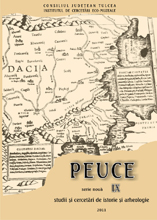Roman Military Expeditions in the Sallentine area (307 and 302 BC)
Roman Military Expeditions in the Sallentine area (307 and 302 BC)
Author(s): Decebal NeduSubject(s): Archaeology
Published by: Institutul de Cercetari Eco-Muzeale Tulcea - Institutul de Istorie si Arheologie
Keywords: Apulia; Cleonymus; Diodorus; Lacinian treaty; Livy; Rome; Tarentum; Sallentini; Kleonymos; Diodor; tratatul lacinian; Titus Livius; Roma; Tarentum; Sallentini
Summary/Abstract: For the year 307 BC, Livy mentions a war waged by the Roman troops in the Sallentine area. Modern historians often took this episode with suspicion although there are no solid grounds for suspecting its reliability. In all likelihood, the Sallentine campaign was carried out by an expeditionary troop detached from the Roman army that had been operating in Apulia. It was a warning for Tarentum and the Romans might have won allies in the Sallentine region beginning with 307 BC. Following the end of the Second Samnite War, in 303 BC, Tarentum asked the Spartan commander Cleonymus for his help in the war with the Lucanian League. Cleonymus’ intention to create a personal dominion in the South of Italy led to the conflict with Tarentum and his allies in the peninsula. Another Livy’s controversial paragraph tells about the Roman military operations against the Spartan general in the Sallentine area, in 302 BC. Again, there is not enough evidence to reject Livy’s information. Rome could have interfered in order to protect its allies from the South of Tarentum which were under the threat of Cleonymus. Caught between Rome and the Spartan commander, the Dorian colony had to find a diplomatic solution to release the pressure from at least one of the adversaries. The year 302 BC is the most plausible date of the Lacinian treaty, which justified the Tarentine attack against the Roman fleet in 282 BC. This treaty guaranteed that Rome would not interfere in Magna Graecia and Tarentum, in his turn, made concessions, recognizing the external status of the allies that Rome had in Apulia and the Sallentine region. Rezumat: Pentru anul 307 a.Chr., Titus Livius menţionează un război purtat de trupele romane în regiunea sallentină. Acest episod a fost privit deseori cu suspiciune de savanţi moderni, deşi nu există argumente solide pentru etichetarea sa ca eveniment inventat. Campania sallentină a fost efectuată, cel mai probabil, de un corp expediţionar detaşat din armata romană care opera în Apulia. Aceasta a fost un avertisment pentru Tarentum şi este posibil ca romanii să fi câştigat aliaţi în zona sallentinilor, începând cu anul 307 a.Chr. După încheierea celui De-al Doilea Război Samnitic, în 303 a.Chr., Tarentum a apelat la serviciile comandantului spartan Kleonymos, deoarece se afla în război cu Liga Lucaniană. Kleonymos a fost tentat să-şi creeze un domeniu personal în sudul Italiei, aspiraţie care l-a adus în conflict cu Tarentum şi aliaţii săi din peninsulă. La nivelul anului 302 a.Chr. un alt paragraf controversat al lui Titus Livius relatează operaţiuni militare romane împotriva generalului spartan, desfăşurate în aria sallentină. Din nou, nu există motive suficiente pentru a respinge menţiunea lui Titus Livius. Intervenţia Romei poate fi explicată prin necesitatea de a-şi proteja aliaţii de la sud de Tarentum, care erau ameninţaţi de Kleonymos. Prinsă între Roma şi comandantul spartan, colonia doriană a trebuit să găsească o soluţie diplomatică pentru a e
Journal: Peuce (Serie Nouă) - Studii şi cercetari de istorie şi arheologie
- Issue Year: IX/2011
- Issue No: 9
- Page Range: 183-203
- Page Count: 20
- Language: English

